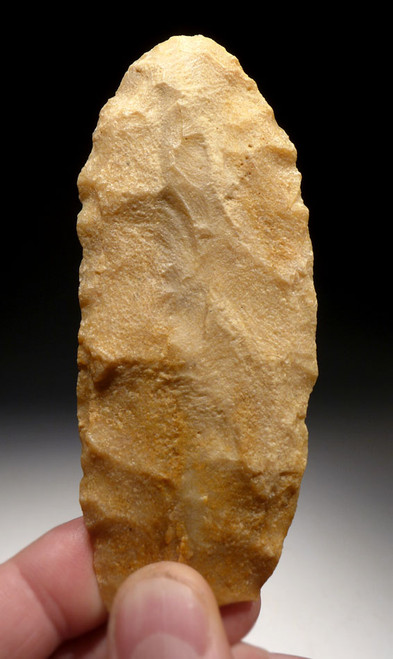Product Description
SEE MORE AFRICAN NEOLITHIC TOOLS AND ARTIFACTS
This EXCEEDINGLY RARE large piriform war macehead comes from the mysterious Neolithic people of the Tenerian Culture of the South Central Sahara Desert. Acquired from the original French collector who ran expeditions to the region in the 1960's and 70's, he confided this was the only drilled macehead of this form he had ever encountered. Made out of vesicular basal, it possesses a cone-shaped piriform profile with a large drilled hole in the center to mount on a wooden shaft handle. Evidence of actual combat use can be seen in the loss to the surface on one side caused by impact. With a weight of 2.5 lbs (1.13 kg), a single blow to the body would surely break major bones, and a strike to the head would prove fatal. This impressive and rare Tenerian weapon would be a 'holy grail' addition to the most rare collections. All surfaces show microscopic sediment deposits, testifying to its original unaltered form and authenticity.
The Earth has been warming and cooling for millions of year, LONG BEFORE the first humans were on the planet. One of the most dramatic examples of climatic change in the last 10,000 years is the desiccation of what is now the Sahara desert. Prior to as recent as 3000 B.C., the South Central Sahara region in Africa was a humid lake savanna. It was home to a thriving culture of ancient humans known as the Tenerians and before them, the Kiffians. The occupation of this area by these two peoples occurred continuously from around 7700 B.C. to the drying of the Sahara in 2500 B.C..
HISTORY
On a dinosaur fossil-hunting expedition in 2000 by a team of scientific explorers led by Paul Sereno, a paleodune and ancient lakebed site was discovered that yielded over 200 ancient burials of Kiffian and Tenerian people. The scientific findings showed that this region was once a humid lake region that was home to these hunter-fisher-gatherer people. The area became known as the "Green Sahara" for its once fertile and habitable landscape. Noted paleontologist, Dr. Paul Sereno, famous for other Saharan dinosaur discoveries, shot into the archaeological spotlight with his discovery of the ancient lakebed cemetery at Gobero in Niger in the year 2000. Interred in the many burials were numerous stone tools, ceramics, shells, beads and bone harpoons typical for the lifestyle of these ancient people of the Green Sahara.
In the final Pleistocene and early Holocene Periods around 10,000 years ago, the South Central Sahara Desert was once a highly favorable environment for hunters, gatherers and pastoralists. Freshwater lakes existed between the dunes in what is now the Tenere region, Lake Chad was eight times its current size, the highlands supported Mediterranean forest trees, and a diverse variety of both large and small fauna flourished there. The slow drying out process of the Sahara, began 7,000 years ago and ended 4500 years ago resulting in the barren conditions that exist to this day. As we progress through time from the end of the Pleistocene towards the end of the Neolithic Period there, we see humans relying more on meat from raised animals as opposed to hunted animals that once roamed wild in the formerly Green Sahara.
 US DOLLAR
US DOLLAR
 EURO
EURO
 AUSTRALIAN DOLLAR
AUSTRALIAN DOLLAR
 CANADIAN DOLLAR
CANADIAN DOLLAR
 POUND STERLING
POUND STERLING






















